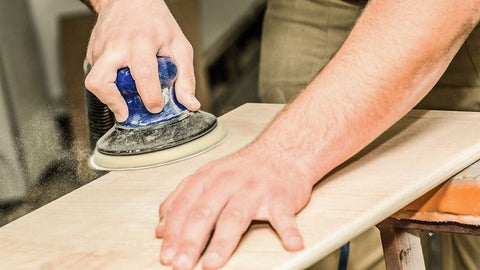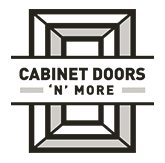
Finishing your cabinets can be an easy and rewarding experience. To change the color of your cabinets, you don't need to be a professional or hire a contractor. Whether you paint or stain your cabinet doors and drawer fronts, here are tips to get your desired look.
Get New Cabinet Doors
1. SEPARATE DRAWER AND DOOR FRONTS FROM YOUR CABINETRY

The key to a successful result is all in the prep work you do on your unfinished cabinet doors and drawer fronts. You might need to lightly sand and prepare the surface before applying your first coat. Unfinished cabinet doors in a paint-grade species might need a little putty and a light sanding for a smooth finish.
Here are some steps to get your cabinet doors and drawer fronts ready for refinishing:
-
Remove the drawer fronts and cabinet doors: To start, remove your cabinet doors and drawer fronts from the cabinets. Your refinishing project will be more comfortable on your arms and back with the cabinet doors off the cabinets. Mark them with a number or location, so you know where each cabinet door or drawer front goes when you complete the job. Remove the hinges and hardware with a screwdriver. To remove the drawer front, take a screwdriver, and remove the screws from the back of the wood panel.
-
Put the wood panels on a safe material: Once you've removed the fronts, you'll want to lay each door and drawer front on a cloth or newspaper. To protect your countertops, you could also cover them with resin paper.
-
Remove the current stain or paint off the surfaces: If these cabinets have paint or stain on them, use a chemical stripper to take off the stain or paint, then sand off any remaining finish. Follow the manufacturer's recommendations when using chemical strippers.
-
Protect yourself from the finish: Wear protective gear for your eyes and hands and work in a well-ventilated area. Work in an open space, like a garage, so once you start staining or painting, you have fresh air. The fumes from the materials can be a little overwhelming.
Make sure that you thoroughly prepare your surfaces before you apply your first coat. Paint or stain will show some of the blemishes once you apply the primer or first coat. Consider a wood conditioner before applying stain for a more even finish.
2. CHOOSE A FINISH OR PAINT COLOR
Choose a finish color for your cabinets and drawer or enhance the natural pattern in the wood grain with a colorless polyurethane finish. Here are some ways to choose a finish color: 
-
Leave your existing wood unfinished: If you like the current natural wood color of your cabinets, you could apply a finish without painting or staining them. A colorless polyurethane finish protects your wood cabinetry from moisture and stain damage.
-
Complement the color of your rooms: Most kitchens and bathrooms are monochromatic for a clean, modern look. You can add a mix of colors to change up the look of your living space. Consider making your cabinet doors a contrasting color to your cabinets. You could also choose different colors for high and low cabinets.
-
Choose between natural wood or a different paint color: One natural wood panel is different from others that look like it. If you'd rather have a bold, uniform look, use any color paint you want on your wood cabinet doors and drawer fronts. White cabinets add a modern, clean look to your bathroom or kitchen. Before you choose a paint color, check the paint's label to find out if you can use it on wood.
-
Consider the texture of your finish: You could choose between matte, semi-gloss and glossy. A matte finish creates a more opaque appearance. A glossy finish adds a reflection to your wood cabinet doors and drawer fronts. How you want to stain unfinished drawer fronts depends on your style.
Match Your Paint

3. SAND THE WOOD
Most manufacturers will have already done the majority of sanding. Some light sanding with fine-grit sandpaper — about 200-400 grit — will help you get the smooth finish you desire. As you start to prep your drawer fronts and cabinet doors, there are a couple of things you'll want to focus on:
- Always sand with the grain, whether it's vertical or horizontal.
- Sand gently. You're trying to get a clean, smooth finish.
- We recommend hand sanding. Powered hand sanders are OK to use, but be very careful. You don't want to sand unevenly or leave some indents or scratches on your door surface.
- If the doors of your cabinets or drawer fronts have some gouges or indentations, this might be a good time to fill them in.
- Wear protective glasses and a mask.
- Make sure you wipe off all the wood dust on the cabinet doors and drawer fronts once completed. Wipe the cabinet components with a damp cloth to remove any dirt or debris.
- Each time you sand the panels, use a hand vacuum and a tack cloth to remove the dust from sanding.

4. FILL IN THE GRAIN AND USE PRE-STAIN CONDITIONER
Before you paint or stain your wood panels, you need to make sure the wood is ready. Here are some ways to get the wood prepared for applying the color:
- Fill in the open grain: Some types of wood, like oak, have open pores in their grain. If you paint your cabinet doors or wood drawer fronts, the open pores will stand out against the paint. Fill in grain pores with a high-build primer and sandpaper for a smooth, clean finish. You could also use a wood-grain filler.
- Apply the pre-stain conditioner: A pre-stain conditioner will help the wood to absorb the stain. You only need one coat of this conditioner. Use latex gloves and a small, clean rag to apply the conditioner.
- Remove the excess conditioner: Let the conditioner sit for 10 minutes. After it's dry, wipe the excess conditioner from your wood cabinet doors or drawer fronts.
5. APPLY A FEW COATS OF THE STAIN OR PAINT

The right stain or paint will transform your cabinet doors and drawer fronts. As you apply each coat, take your time to avoid creating bubbles or blobs on your wood panels. Get the best finish for your drawer fronts and cabinet doors by working carefully.
When you complete your prep work, you're ready to apply the first coat. Keep in mind that you'll be doing several layers. Try to keep each coat the same thickness. Don't try to finish the cabinets or cabinet doors and drawers with one coat. To do this right, you'll end up with at least two layers of stain or paint. Keep in mind that the more coats of stain you apply, the darker your wooden cabinetry will turn out.
To finish your cabinet doors or drawer fronts, you'll need some good paintbrushes, a couple of cloths or rags and some fine-grit sandpaper. You could also use some old t-shirts.
Here's our opinion on how to stain or paint unfinished cabinets and drawer fronts:
-
Stain: Use a lint-free cloth or clean rag when staining kitchen cabinets, as most stains are very thin. A cloth or rag allows an even application by rubbing the stain into the wood. A high-quality foam paintbrush might work as well. This tool is exceptionally efficient if the wooden components of your cabinetry have a panel profile with a sharp edge. Staining with a paintbrush takes longer and might leave brush marks. When you finish your cabinetry, follow the manufacturer's directions for the best results.
-
Paints: There are two types of paint — latex and oil. Whichever type you use, we recommend using a new, clean paintbrush. To get the best results, use a softer bristle brush for latex paints and a stiffer brush for oil paints. Follow the direction of the grain on your wood to get the best appearance. Wipe the edges of your cabinet doors or drawer fronts to prevent a buildup of too much paint.
Work in a well-ventilated area when you start to paint, stain or varnish your cabinets. Sanding between coats is critical. As you apply the first coat of your selected finish, you may see brush marks, small bubbles or dust on the surface. Once your first coat is dry, use the same 200-400 grit sandpaper to remove these marks or bubbles and smooth out the finish.

6. BRUSH ON THE FINISH TO PROTECT YOUR CABINETS FROM DAMAGE
The final step is putting on the finish. A high-quality finish is necessary for protecting your wood from moisture damage or scratches. To maintain your cabinet or drawer front's new color, apply a few coats of finish to the surface.
Work in a well-ventilated area, so you don't breathe in the toxic fumes of the finish. You should also make sure that the wood panels are dry from the paint or stain you use. Read the label on the paint or stain to find out how long to wait for the coats to dry. Here are some tips for how to finish drawer fronts:
-
Use the right tools: You can use a brush or lint-free cloth, but it might be best to get a smooth finish and full coverage with a clean rag. You can apply other oil-based clear coats with either a brush or a cloth. Cloths allow you to finish with a thin, even coating.
-
Choose the right finish for your project: If you stain your cabinet components, add a colorless polyurethane finish. Apply an oil-based polyurethane finish if you used an oil-based paint or stain. If you're worried about the adhesion of your color, use an acrylic urethane finish. Urethane can stick to almost any surface, so you'll have reliable moisture resistance. You can use acrylic urethane as a primer before you begin the painting process, or you can apply it as the final coat.
-
Wipe off the excess finish: After you've applied the finish, wipe off the excess to create a clean look. Make sure the cloth you use doesn't have any dust on it. Dust particles can create small bumps in the finish of your cabinetry.
Once the cabinet doors and drawer fronts are dry, re-attach the hinges and hardware. And now enjoy the fruits of your labor and show all your friends your new kitchen or bath!
When staining wood, everyone who knows the basics can be pretty successful in making their cabinets look like they want. When your stain does not come out as you anticipated, that could be problematic for you and the wood. If your cabinet door and drawer front refinishing damages your cabinetry, you may need to replace them.


BUY NEW CABINET DOORS AND DOOR FRONTS FROM CABINET DOORS 'N' MORE
At Cabinet Doors 'N' More, we provide new cabinet doors, drawer fronts and drawer boxes. You can order as little as one cabinet door or many different cabinetry items for your next large-scale project. Browse through our collection of high-quality replacement drawer fronts and cabinet doors to get started on your next DIY project.
You could get matching drawer fronts to complement your cabinet doors. We offer an extensive selection of different wood materials for your cabinetry:
- Solid wood: Solid wood comes in a variety of materials and textures. It's durable and easy to repair if something happens. If applying a urethane finish, choose a wood species that accepts stain, like hard maple, red oak or cherry.
- Wood veneer: Wood veneer panels are lightweight and stable. This lightweight material is accessible for you to transport and manipulate.
- MDF: Medium-density fiberboard (MDF) is resistant to warping and temperature changes. MDF is easy to paint and stain and requires little prep work.
- RTF: Rigid thermofoil (RTF) cabinetry is high-quality and durable for your DIY remodeling project.
When you buy custom cabinetry from Cabinet Doors 'N' More, you have more options for how you want your doors and drawer fronts to look. Raised panels tend to look more traditional, while flat slab doors work well for a sleek, modern look. Lite cabinet doors have spaces in them for windows. Slip in a panel of glass to display your decorative kitchen set.
After you've decided what material and shape you want, measure the space where you'll be installing your cabinetry. Put the measurements of the area you need cabinetry into a form on our website. We can ship many of our products in as little as 10-15 business days.
Buy $750 or more in cabinet doors, drawer fronts, drawer boxes or accessories, and get 10% off your entire order. We take off the discount at check out. Discounts cannot be combined. Contact us online for more information or call 1-667-877-8777.



Learn More About Painting & Staining Cabinets
















Thomas Clarence
January 18, 2024
It stood out to me when you talked about how it is important to use the right tools when staining unfinished cabinets. With that in mind, I would think that it would be a good idea to hire a painting and staining expert if you have unfinished cabinets. Hiring an expert makes sense because they would have all of the tools necessary for a project like this. https://www.kdpaintingplus.com/